Pump Handbook by Igor J. Karassik, Joseph P. Messina, Paul Cooper, Charles C. Heald - 3rd edition
Подождите немного. Документ загружается.

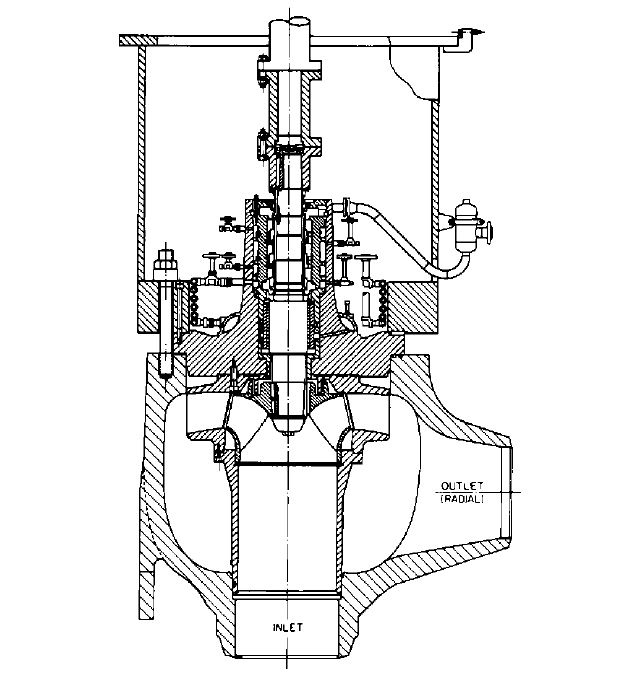
9.14.1 NUCLEAR ELECTRIC GENERATION 9.291
FIGURE 8 Main coolant pump (Sulzer Pumps)
In addition, a safety seal may also be installed as a backup. At least one manufacturer
uses a high-pressure ceramic seal with a carbon seal backup followed by a vapor seal.
Main coolant pump seals are usually supplied with reactor-grade water through a seal
injection system. The advantage of using injection water is that it can be temperature-
controlled and filtered. Most pumps, however, can be operated without it for at least rea-
sonable time periods.
PRINCIPAL TYPES OF PUMPS__________________________________________
Most of the pumps in nuclear service are one- or two-stage centrifugal motor-driven
pumps. Both vertical and horizontal types are used. Charging, safety injection, feedwater,
and other high-head pumps are usually multistage motor-driven centrifugal units. Some
requiring high power are turbine-driven. Double-suction designs are frequently used for
RHR pumps, where service requires operation at low available NPSH. Reciprocating
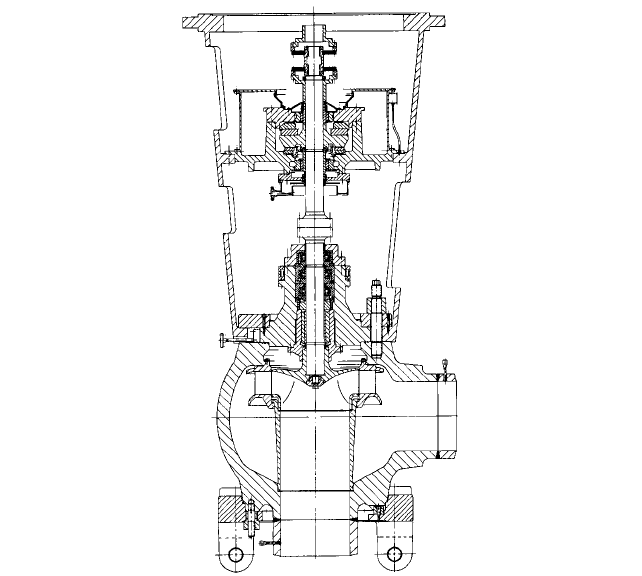
9.292 CHAPTER NINE
FIGURE 9 Main coolant pump (CE-KSB Pump)
pumps find limited service in nuclear plants for make-up flow, seal injection flow, or chem-
ical mixing service. Canned pumps are frequently used in subsystems where their zero-
leakage capabilities can be exploited.
Figure 12 shows a multistage centrifugal pump used in charging and safety injection
service.
Figure 13 illustrates a reciprocating pump often used for charging and hydrostatic test
service. It is rated at 98 gpm (22 m
3
/h) at 5800 ft (1768 m) head. In Figure 14, a vertical
multistage unit is shown. This type of unit is common in heater drain service. Figure 15
shows a single-stage pump of a type used in many service functions in a nuclear plant.
Typically, its flow is 75 gpm (17 m
3
/h) with a developed head of 235 ft (71.6 m) at 3500 rpm.
SPECIAL REQUIREMENTS FOR NUCLEAR SERVICE PUMPS________________
It is in the area of special requirements that nuclear service pumps differ most widely
from commercial products. These special requirements, described in greater detail later,
far exceed the requirements of the general industrial field and illustrate the strong
emphasis placed upon pressure integrity and pump operability.
Nuclear-grade pumps are designed, built, inspected, tested, and installed to rigid stan-
dards of the U.S. Nuclear Regulatory Commission, the American Society of Mechanical
Engineers, the American National Standards Institute, and other regulatory agencies,
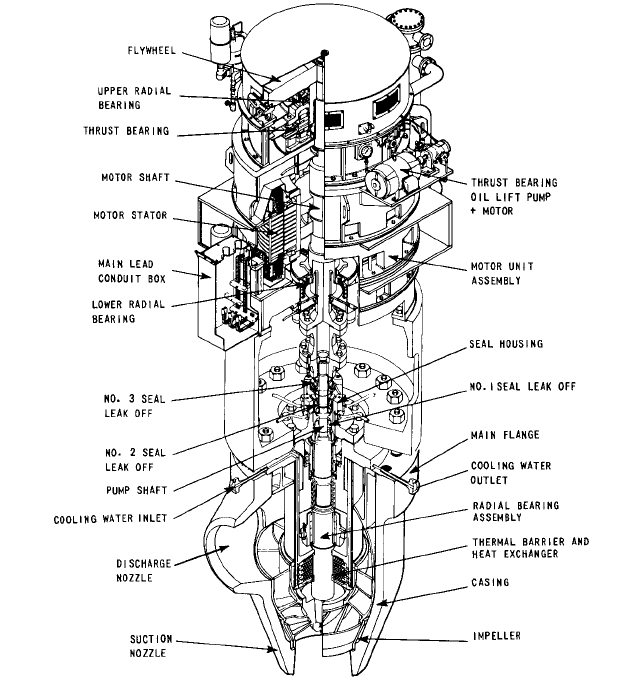
9.14.1 NUCLEAR ELECTRIC GENERATION 9.293
FIGURE 10 Main coolant pump (Westinghouse Electric)
such as state and local jurisdictional bodies. Established rules can be divided into two dis-
tinct categories: (1) those controlling integrity of the pressure-retaining boundary and (2)
functional considerations.
The hydraulic design of nuclear pumps is the same as that of pumps in conventional
service. For recirculation and reactor coolant pumps, a radial discharge is preferred by
some users because it tends to simplify certain aspects of the plant design.
Vibration characteristics of pumps in nuclear service are especially important because
of the relative inaccessibility of the equipment for checking and servicing and because
safety requirements permit only limited outage of pumps; otherwise, the plant must come
to standby condition.
An analytical or experimental determination of lateral and torsional natural frequen-
cies is routine for most pump-driver combinations, and occasionally a transient analysis
may be required.
Design under ASME Code Rules Under the rules established by the ASME Boiler and
Pressure Vessel Code, Section III (Nuclear Components), the owner, such as the plant
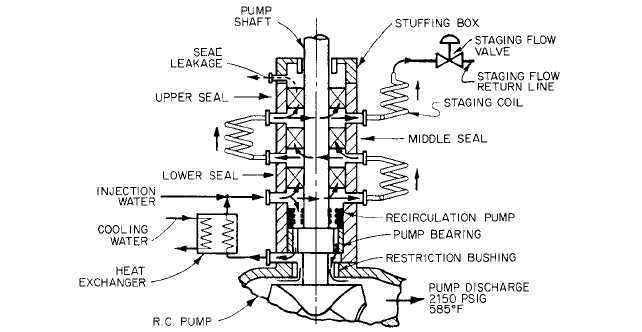
9.294 CHAPTER NINE
FIGURE 11 Flow schematic for a reactor coolant pump seal (Sulzer Pumps)
designer or public utility, either directly or through an agent, prepares a design specifi-
cation for a specific pump, which in code terms is a component. This specification must be
approved by a licensed Professional Engineer and list the applicable ASME Code Year and
Addenda.
The manufacturer builds the pump to the design specification. Verification is provided
through the combined efforts of the material supplier, manufacturer, insurance inspector,
and state and local enforcement agencies.
The design specification requires compliance with the rules of the code with regard to
the design of the pressure boundary and, in addition, includes supplementary require-
ments prescribed by the owner. Other standards are invoked as applicable to meet the
safety and environmental requirements of the U.S. Nuclear Regulatory Commission.
Functional needs may be included, and the code class to which the pump is to be built
must be identified.
There are three ASME code classes for pumps. For the most critical service, a Class 1
pump is specified. Class 2 represents a pump serving a less critical system, and Class 3
is the lowest-class pump for nuclear service. It is the owner’s responsibility to establish
the pump class, with guidance provided by the Nuclear Regulatory Commission and the
manufacturers.
For the pressure boundary evaluation, a Class 1 pump, by code rules, receives the
most detailed analysis using verified and validated modern design techniques. These
techniques must be supported, if necessary, by experimental stress analysis, and a certi-
fied Design Report must be submitted to the customer to document adherence to the code.
Fatigue analysis of critical portions of the pump may be required, and behavior under all
plant conditions, including accident, must be evaluated. Class 2 pumps require less
analysis, but a certified Design Report is still required, documenting compliance with the
customer’s specification and the code. For Class 3 pumps, even wider latitude of design is
permitted, but a certified Design Report must still be submitted to the customer. All three
classes of pumps are to receive an ASME N-stamp by a qualified pump manufacturer
upon successful completion of design, manufacture, inspection, test, and document
review.
Additionally, nuclear service pumps are usually examined in design for thermal
steady-state and transient conditions, behavior under seismic disturbances, conditions of
nozzle loadings imposed by system piping, means of support, and accessibility for service,
in-service inspection, and replacement.
Rules for quality control during material procurement, manufacture, and test are also
contained in the code. Nondestructive examination and document control are detailed, and
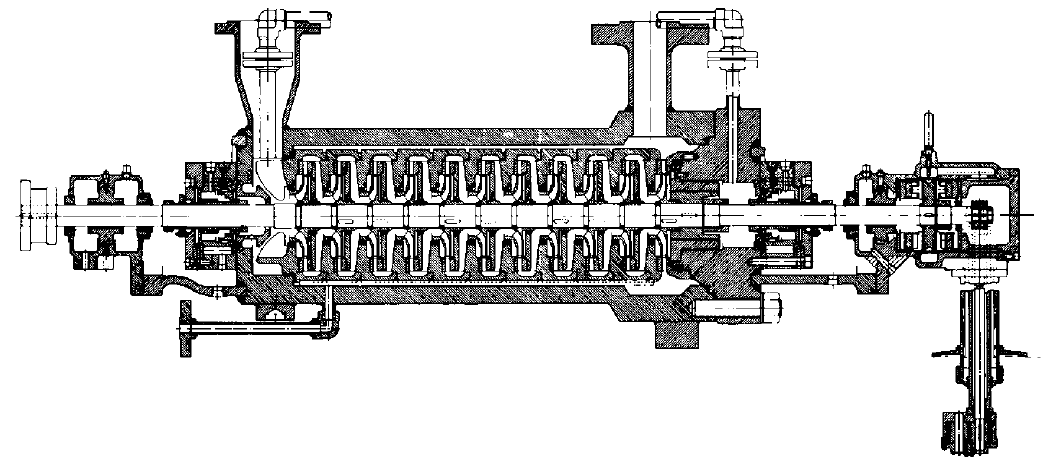
9.295
FIGURE 12 Pump for PWR charging and safety injection service (Flowserve Corporation)
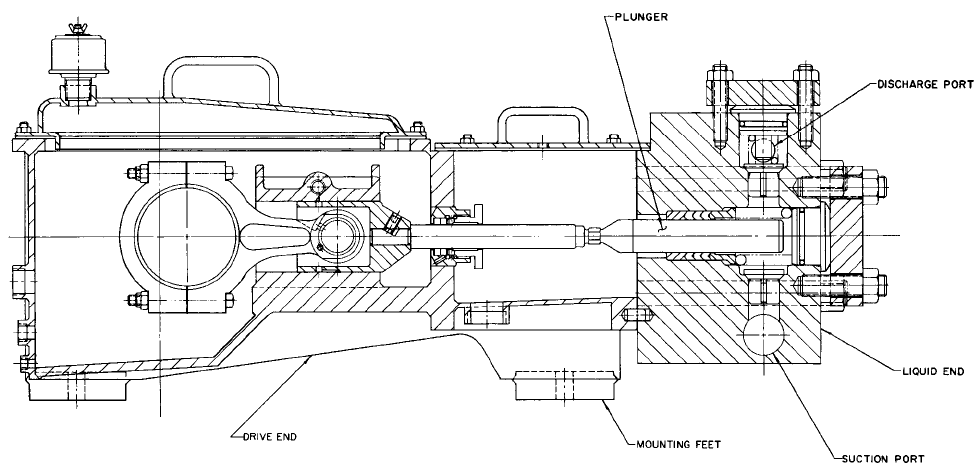
9.296
FIGURE 13 Reciprocating pump for nuclear service (Gaulin)
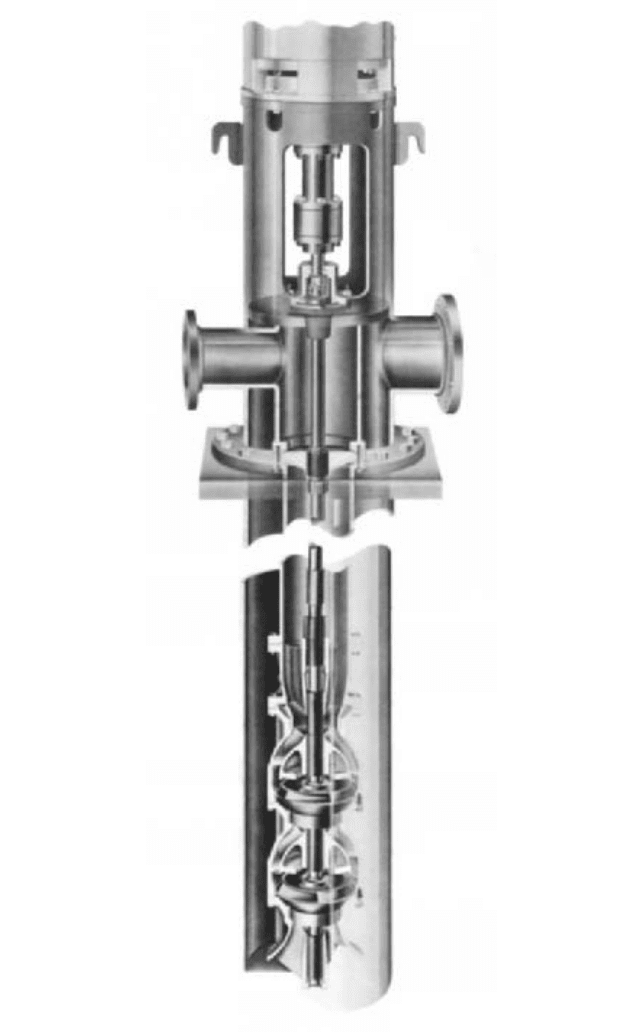
9.14.1 NUCLEAR ELECTRIC GENERATION 9.297
FIGURE 14 Vertical multiple-stage pump (Flowserve Corporation)
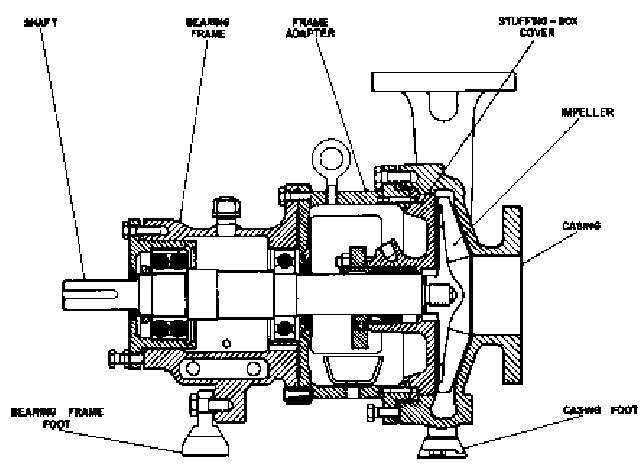
9.298 CHAPTER NINE
FIGURE 15 Single-stage pump used for many service functions in a nuclear plant (ITT/Gould Pumps, Inc.)
a quality assurance program requiring a formal procedure manual must be prepared and
implemented by the manufacturer. Periodic surveys by the ASME verify adherence to code
rules. Local jurisdictional authorities provide day-to-day inspection services as required by
the manufacturer.
Design of Noncoded Parts Parts of the pump that are not classified as pressure
boundary items or attachments to the pressure boundary are not covered by the ASME
code.The owner’s design specification may describe applicable requirements for these non-
pressure parts, referencing other documents or excluding use of certain objectionable
materials. If the pump is in critical service or is needed in emergency situations, certain
ANSI standards may be invoked. Accompanying these rules will be extensive quality
assurance and documentation to demonstrate compliance.
MATERIALS OF CONSTRUCTION _______________________________________
Material Limitations
When pumps built to ASME standards are required, materials for
the pressure-retaining parts must be selected from a list approved by the ASME. Section
III (Nuclear Components) of the ASME Boiler and Pressure Vessel Code lists these mate-
rials, their allowable stresses, and the examination requirements that must be applied to
ensure their suitability.
Typical Materials Examples of acceptable materials for pressure-retaining boundary
parts are shown in Table 3. They are suitable for all three ASME code classes; however,

9.14.1 NUCLEAR ELECTRIC GENERATION 9.299
TABLE 3 Materials for pressure-retaining boundary parts
Carbon steel
Castings SA-216, Gr WCA, WCB, WCC
Forgings SA-105, Gr I, II
Plate SA-515, Gr 55, 60, 65, 70
Bolting SA-193, Gr B6, B7, B8, B16
Stainless steel
Castings SA-351, Gr CF8 (304), CF8M (316)
Forgings SA-182, Gr 304, 316, 321, 347
Plate SA-240, Gr 304, 316, 321, 347
Nonferrous
A limited number of nonferrous materials are permitted.
other acceptable materials may be restricted to use for a particular class. Hazardous and
porous materials are generally avoided, as are materials such as cobalt, which, though
normally harmless, may become hazardous from radioactive considerations (see following
text). Cobalt content is often limited in large stainless steel parts but is usually permit-
ted in concentrated form of small areas, for example, where hard-facing is required.
Materials of construction should not be affected by the usual decontamination chemicals.
Nonpressure boundary parts may be made of conventional materials but will usually
require the buyer’s approval. Certain elastomers, such as ethylene propylene, which has
good radiation stability, are excellent for seal parts. Many fine grades of carbon-graphite
are available for water-lubricated bearings and for mechanical seal facings.
CONSIDERATIONS OF RADIOACTIVITY __________________________________
Radioactivity may become a serious consideration in the design of nuclear pumps because
of the need for servicing the equipment. The water used in the primary system becomes
contaminated with metallic elements through solubility, corrosion, and erosion. When cir-
culated through the core region, the metallic elements become radioactive because of inter-
action with neutrons.These radioactive contaminants may, if soluble, remain in solution in
the water or, if unsoluble, plate out on metal surfaces or become lodged in “crud traps,” such
as fit interfaces, screw threads, porous base metals, extremely rough surfaces, cracks, and
certain types of weld configurations, such as socket welds. In one case, for instance, a pump
impeller returned for overhaul defied attempts at decontamination until it was discovered
that a repair had been made to a presumably integral wear ring by undercutting and
shrinking on a new ring. The interface was barely perceptible, but once it had been found
and the ring had been removed, the impeller was readily decontaminated.
Soluble contaminants are most easily removed by providing the pump with complete
drainage features; that is, leaving no internal pockets that are not naturally drainable.
Ease and speed of parts replacement are, therefore, also important items of design because
they reduce the length of time service personnel are exposed to radiation.
The Nuclear Regulatory Commission (NRC) provides specifications detailing the
allowable radiation exposure to personnel. Any pump that produces radioactivity at rates
that would exceed these limitations must either be repaired at a facility licensed to han-
dle contaminated material or be decontaminated prior to being sent to a conventional
repair shop.
After prolonged service in a nuclear plant, pumps may emit radioactivity at a rate in
excess of 2 to 50 rem/hr, far in excess of the NRC limits. Therefore, provisions to deconta-
minate nuclear pumps becomes an important design characteristic. Although not all
nuclear pumps operate in highly radioactive environments, these pumps will usually
require some degree of decontamination before they can be freely handled and repaired.
9.300 CHAPTER NINE
SEISMIC DESIGN_____________________________________________________
The ASME code requires that a seismic analysis be performed on all classes of nuclear
pumps. Refer to Subsection 9.14.2 for more detailed information on this subject.
TESTING____________________________________________________________
Hydrostatic Testing
Hydrostatic testing in accordance with ASME code rules is con-
ventional except that specific documentation is required.
Performance Testing Performance of nuclear pumps is verified by procedures common
to non-nuclear pumps. In addition, however, it may be necessary to demonstrate pump
performance under some emergency condition, such as loss of cooling water or seal injec-
tion water. Also, a test under simulated total-loss-of-power conditions may be required, in
which the reactor coolant pump must coast safely to a stop and withstand loss of both cool-
ing and seal injection water for a finite time.
Periodic Testing The ASME code, under its rules for in-service inspection (Section XI),
requires periodic testing of certain pumps installed in a nuclear plant.The pumps affected
by these rules are those associated with the safety systems and those that may be required
to function during an emergency or a reactor shutdown. Examples of such pumps are
those for core spray, residual heat removal, boron injection, and containment spray. If
pumps cannot be tested in their usual circuit, they must be supplied with bypass loops
that can be valved off.
The field testing procedure involves obtaining a baseline set of values for head, flow,
speed (if variable), vibration, inlet pressure, and bearing temperatures. The flow quantity
that sizes the bypass loop is not specified in the code, but in the practical sense, the flow
must be adequate to prevent overheating of the pump and overloading of the bearings.
Also, because it is an off-design point, consideration is given to the potential for rough
operation due to impeller internal recirculation and possible low-flow cavitation damage.
Code rules call for a five-minute running period every three months and longer periods
where it is necessary for bearing temperatures to stabilize. If the differences between peri-
odic operating data and baseline data exceed permissible limits, the cause for the differ-
ences must be sought and corrected. Record-keeping is therefore a significant part of pump
in-service testing.
